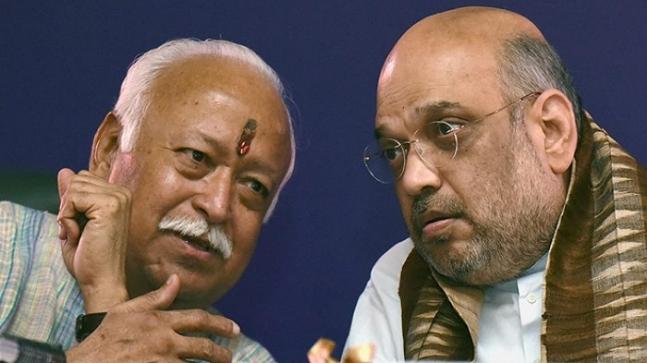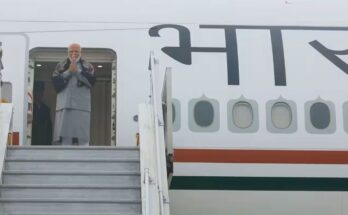By Nirendra Dev
A man is known by the company he keeps. This is generally true for the BJP as a political outfit vis-a-vis its relationship with the RSS.
In fact, doyens of pro-Hindutva philosophy politics like L K Advani have called RSS-BJP bond as the umbilical cord.
As the country goes to the last phase of polling on Sunday to elect 59 MPs for the 543-member Lok Sabha, it is not without good reason that all eyes are on the future course the Sanghparivar fountainhead RSS chooses for itself.
It is more than an exciting event on cards as time and again an impression has gone that ‘Nagpur’ does not approve of the Narendra Modi-Amit Shah ‘hegemony’ in all aspects of running of the saffron party.
To examine the query – What’s the roadmap ahead for the RSS? – one would safely – it will depend on the final election results on May 23.
However, the past and the present events related to RSS-BJP relationship deserve a closer scrutiny.
Contrary to the impression that it is Prime Minister Modi chiefly who is pushing all veterans into sidelines – sources both in BJP and RSS confirm that right from 2013 the Sanghparivar fountainhead has been in “control” of things.
On March 31, 2013 – precisely the Easter Day – the then BJP president Rajnath Singh announced the office bearers’ names and also the national executive of the party.
It had a fine balance of caste, community and politico-societal considerations. But more importantly – the new team of BJP had a clear imprint of the RSS.
“Kisi ek neta ki nahi chali (No single leader should be credited for BJP’s new team),” a key RSS functionary has said in April 2013.
The party leaders later confirmed and also post-2014 publicly it became clearer that the RSS had the Generation Next prepared in the cloak of Team Rajnath of 2013.
A senior leader later summed up the complex decisions in fewer words – “For the first time in 33 years since the formation of BJP in 1980, the party had shown ‘dead woods’ their place and created a second generation practically in every state”.
This push to the ‘generation next’ polity was given a much crucial bolster in 2014 after Amit Shah replaced Rajnath Singh as the president.
The move to inculcate fresh blood or new faces was refreshing and RSS insiders later said the ‘transition’ was akin to L K Advani’s moves in 1980s when the likes of Pramod Mahajan and Sushma Swaraj were encouraged.
In 2014, it goes without saying the RSS also deputed one of its dynamic and then a ‘media friendly’ personality Ram Madhav as the BJP general secretary.
While PM Modi and BJP chief Shah are often accused of being ‘autocratic’, in the case of Ram Madhav – he was not only given key responsibilities to handle trouble torn state of Jammu and Kashmir and “almost a free hand” about Nagaland and other north eastern states.
BJP sources in Assam confirm that more than once Ram Madhav handled ‘complex’ things in the region especially with regard establishing ties with nascent NDPP of Neiphio Rio in Nagaland or to bring back AGP into NDA after it staged a walkout over the Citizenship Amendment Bill.
On May 17 – the last day of election campaign – as Prime Minister made an appearance for a joint press conference with Mr Shah – another person to his right was Ram Lal, a key RSS nomination.
Sanghparivar leaders also say that in 2013 – the RSS chief Mohan Bhagwat had categorically instructed Rajnath Singh no general secretary should be above 50.
”It was our blueprint for the future. A cadre-based party like the BJP functions led by general secretaries,” the source said.
At the same time Mohan Bhagwat was understood to have given ‘some liberty’ to Narendra Modi and thus Amit Shah was allowed to be made the general secretary in charge of Uttar Pradesh.
It certainly goes to the credit of Modi-Shah duo and of course key support from Rajnath Singh that the BJP was revived in country’s most populous state. UP ultimately gave BJP 71 seats in 2014 and with its ally Apna Dal – NDA had 73 of the 80 seats.
In last five-six years – sources say the RSS-BJP leadership bond has been very smooth and balanced.
In fact, both Rajnath Singh and Amit Shah worked to a good script and ensured that the BJP is in the right synchronisation with the RSS on Ram temple and other pro-Hindutva agenda like Jammu and Kashmir and Uniform Civil Code.
In 2017 – the Sanghparivar fountainhead allowed Yogi Adityanath to be made the UP Chief Minister notwithstanding the fact that Yogi personally did not have RSS background.
However, no final word can be said about politics; and more so in the manner RSS leadership would handle the post-May 23 situation.
If Modi-Shah duo repeats the success tale of 2014 – as many BJP and RSS leaders believe will happen – the status quo will prevail.
But in case – all calculation goes topsy-turvy – heads will certainly roll. (UNI)




